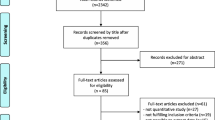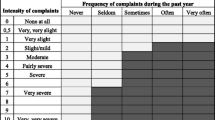Abstract
Objectives: To gain more insight into the prevalence rates of musculoskeletal complaints of neck-shoulder and low back and to determine the relation between physical and psychosocial work-related risk factors and the complaints mentioned in non-specialized nurses, operation room nurses, Intensive Care (IC) nurses and X-ray technologists. Methods: The study population consists of 3,169 employees affiliated to eight university hospitals in the Netherlands. The study was conducted using a cross-sectional survey design. The parameters under study were having or having had (severe) low back or neck-shoulder complaints during the past year. In logistic regression analyses odds ratio’s and CI 95% were estimated for all relevant risk factors for each of the four professional groups. Results: In all groups prevalence rates of musculoskeletal complaints were high: low back 76%, neck-shoulder 60%. Operation room nurses perceived more neck-shoulder complaints (12 months prevalence) than non-specialized nurses and IC nurses perceived less severe low back complaints than non-specialized nurses. Four physical risk factors and one psychosocial factor were associated with low back complaints in all groups. Conclusions: The results of the present study indicate that both low back complaints and neck-shoulder complaints are major health problems in the four professional groups under study. The prevalence rate of neck-shoulder complaints in operation room nurses is higher than in non-specialized nurses and IC nurses, the latter groups having high prevalence rates already. The exposure to risk factors is perceived differently by each of the professional groups. The professional groups under study all are target for preventive interventions; these interventions need to be specified for each of the professional groups.
Similar content being viewed by others
References
Alexopoulos EC, Burdorf A, Kalokerinou A (2003) Risk factors for musculoskeletal disorders among nursing personnel in Greek hospitals. Int Arch Occup Environ Health 76:4–294
van der Doef MP (2000) The job demand-control-(support) model from past tot the future. Thesis, Leiden University, The Netherlands
Engels JA, Landeweerd JA, Kant Y (1994) An OWAS-based analysis of nurses’ working postures. Ergonomics 37:5–19
Engels JA, van der Gulden JW, Senden TF, van’t Hof B (1996) Work related risk factors for musculoskeletal complaints in the nursing profession: results of a questionnaire survey. Occup Environ Med 53:9–41
Engkvist IL, Hagberg M, Hjelm EW, Menckel E, Ekenvall L (1998) The accident process preceding overexertion back injuries in nursing personnel. PROSA study group. Scand J Work Environ Health 24:5–75
Hildebrandt VH (1995) Back pain in the working population: prevalence rates in Dutch trades and professions. Ergonomics 38:1283–1298
Hildebrandt VH, Bongers PM, van Dijk FJ, Kemper HC, Dul J (2001) Dutch musculoskeletal questionnaire: description and basic qualities. Ergonomics 44:12–55
Huizingh E (2002) Introduction SPSS for windows and data entry (Inleiding SPSS 11.00 voor Windows en Data Entry). Academic Service
Kant IJ, de Jong LC, Rijssen-Moll M, Borm PJ (1992) A survey of static and dynamic work postures of operating room staff. Int Arch Occup Environ Health 63:6–8
Kumar S, Moro L, Narayan Y (2003) A biomechanical analysis of loads on X-ray technologists: a field study. Ergonomics 46:5–17
Kuorinka I, Jonsson B, Kilbom A, Vinterberg H, Biering-Sorensen F, Andersson G et al (1987) Standardised Nordic questionnaires for the analysis of musculoskeletal symptoms. Appl Ergon 18:3–7
Lagerstrom M, Wenemark M, Hagberg M, Hjelm EW (1995) Occupational and individual factors related to musculoskeletal symptoms in five body regions among Swedish nursing personnel. Int Arch Occup Environ Health 68:1–35
Lagerstrom M, Hansson T, Hagberg M (1998) Work-related low-back problems in nursing. Scand J Work Environ Health 1998 Dec; 24:6–64
Meijsen P (2004) Physical load in operation room nurses (Fysieke belasting bij operatieassistenten). Veldhoven
Nunnally JC (1967) Psychometric theory. McGraw-Hill, New York
Picavet HS, Schouten JS, Smit HA (1999) Prevalence and consequences of low back problems in The Netherlands, working vs non-working population, the MORGEN-Study. Monitoring project on risk factors for chronic disease. Public Health 113:2–7
Schuring M, Sluiter JK, Frings-Dresen MHW (2001) Criteria document for evaluating the work-relatedness of upper-extremity musculoskeletal disorders. Scand j work environ 27:1
Trinkoff AM, Lipscomb JA, Geiger-Brown J, Brady B (2002) Musculoskeletal problems of the neck, shoulder, and back and functional consequences in nurses. Am J Ind Med 41:3–8
Trinkoff AM, Lipscomb JA, Geiger-Brown J, Storr CL, Brady BA (2003) Perceived physical demands and reported musculoskeletal problems in registered nurses. Am J Prev Med 24:3–5
University Hospitals Associaton (1999) Project health and safety covenant (plan van aanpak arboconvenant)
de Vet HC, Heymans MW, Dunn KM, Pope DP, van der Beek AJ, Macfarlane GJ et al (2002) Episodes of low back pain: a proposal for uniform definitions to be used in research. Spine 27:21–16
de Winter C, Grundemann R (1992) The questionnaire work and health in human resource management. In: Methods, technics and analyses (De vragenlijst arbeid en gezondheid (VAG) in personeels- arbobeleid. In: Methoden, technieken en analyses). Deventer, Kluwer
Author information
Authors and Affiliations
Corresponding author
Appendix
Appendix
The Dutch musculoskeletal questionnaire (DMQ): five physical and five psychosocial factors (Hildebrandt et al. 2001)
Factor | N items | Content | Cronbach’s alphaa | Cronbach’s alpha |
|---|---|---|---|---|
Force exertion | 13 | Lifting, pushing and pulling, carrying, forceful movements with arms, high physical exertion, lifting with loads above the chest, lifting with bad grip, lifting with very heavy loads, short force exertion, exerting great force in hands | 0.86 | 0.90b |
Dynamic load | 12 | Trunk movements (bending and/or twisting), movements of neck, shoulders or wrists, reaching, make sudden and/or unexpected movements, pinching, working under, at, or, above shoulder level. | 0.80 | 0.82b |
Static load | 11 | Light bent, twisted trunk posture, heavily bent, twisted trunk postures, postures of neck or wrists | 0.82 | 0.87b |
Repetitive load | 6 | Working in the same postures, making the same movements with trunk, arms, hands wrists or legs, making small movements with hands at a high pace | 0.80 | 0.85b |
Ergonomic environment | 6 | Available working space, no support, slipping and falling, trouble with reaching things with tools, not enough room above to perform work without bending | 0.70 | 0.78b |
Job content and autonomy | 6 | Monotony, skill level, challenging, new skills, learn new things, variation | 0.68 | 0.57c |
Job demands | 6 | Work pressure, (problems with) speed of work, fatigue | 0.70 | 0.76c |
Work organization | 5 | Organization degree, work progress, hinder of unexpected situations, presents of colleagues or lack in work of others | 0.56 | 0.58c |
Task control | 5 | Determine workpace, - the order of tasks, make decisions in the job, leave the workplace for a while | 0.72 | 0.67d |
Supervisor and colleagues | 5 | Daily leadership, irritation of others, supervisor pays attention to what I am saying, good work atmosphere, impression of supervisor of my job | 0.67 | 0.78c |
Rights and permissions
About this article
Cite this article
Bos, E., Krol, B., van der Star, L. et al. Risk factors and musculoskeletal complaints in non-specialized nurses, IC nurses, operation room nurses, and X-ray technologists. Int Arch Occup Environ Health 80, 198–206 (2007). https://doi.org/10.1007/s00420-006-0121-8
Received:
Accepted:
Published:
Issue Date:
DOI: https://doi.org/10.1007/s00420-006-0121-8




